Autographic
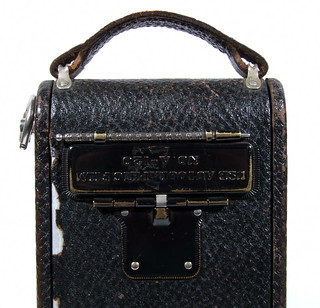
|
| Window and stylus No. 1 Autographic Kodak Jr. image by Süleyman Demir (Image rights) |
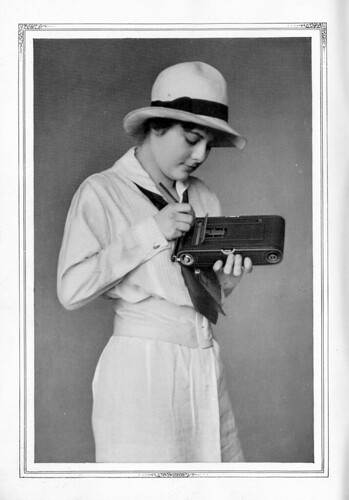
|
| A lady using the Autographic camera (in Eastman Kodak advertising) scanned by Mario Groleau (Image rights) |

|
| Front-mounted stylus image by Geoff Harrisson (Image rights) |
Autographic film and cameras, Eastman Kodak products from 1914 onward, allowed the photographer to enter his or her own notes onto the negative, rather like an early data back. Comments are written with a stylus in a window in the camera back, onto the paper backing of the film, which incorporates a carbon-paper. This leaves the backing slightly translucent where the stylus passed. The writing window is then exposed to the daylight and the inscription burned onto the negative.
The method was invented by Henry Jacques Gaisman, who patented it in several forms, perhaps to prevent similar designs being patented by rivals (see the various patents below), over several years. In the various designs, the inscription is made on the film in several ways:
- Carbon powder from a carbon paper is transferred to the emulsion side of the film, and casts a shadow when the film is exposed through the lens; the lettering should be dark-on-light, in the finished print, and appear in the picture area.
- The emulsion itself is compressed against a textured surface, and this changes its response when exposed; the lettering should appear as stippling, either in or outside the picture area, according to different designs.
- Carbon is transferred to a translucent backing paper, and the writing casts a shadow on the film when exposed to light from behind (after the carbon paper is removed); The lettering should be dark-on-light, and appear outside the picture area.
- The carbon layer of the carbon paper is disrupted by writing on it, and so allows more light through (the film is exposed from behind, with the carbon paper in place); this is the form of the invention actually made. The lettering is light-on-dark in the finished print (dark-on-light in the negative, as in the example pictured here), and appears outside the picture area.
Eastman Kodak was party to Gaisman's patents from the outset. Kodak made a series of Autographic cameras and even replacement backs to adapt older cameras to use this feature, and produced Autographic film for eight different negative sizes. The smallest was A127 (1½×2½ inches) and the largest A126 (4½×6½ inches).
The form of the Autographic window can help date the camera, as Kodak produced three consecutive models in 20 years. The first version is shown in the advertising picture, the middle version is shown above it and the later version is below.
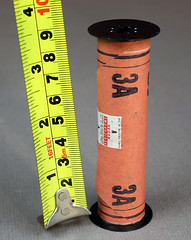
|
| Autographic Verichrome Film Size A122 image by Frank Reiser (Image rights) |

|
| A127 size Autographic negative (Surely not that fine young lady's handwriting!) image by Geoff Harrisson (Image rights) |
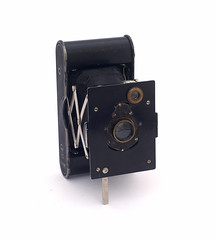
|
| Vest Pocket Autographic image by Steve Harwood (Image rights) |
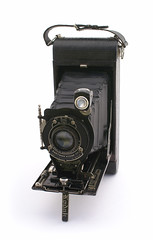
|
| No. 1A Pocket Kodak image by Steve Harwood (Image rights) |
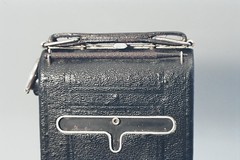
|
| Window of No. 1 Pocket Kodak image by Dries van den Elzen (Image rights) |
Links
- Kodak products including Autographic film at Early Photography.
- Autographic film at Scott's photographica
- Autographic Film at Mischa Konig's Kodak Classics
- Patents held by Henry J. Gaisman relating to Autographic cameras, at Espacenet, the patent search facility of the European Patent Office:
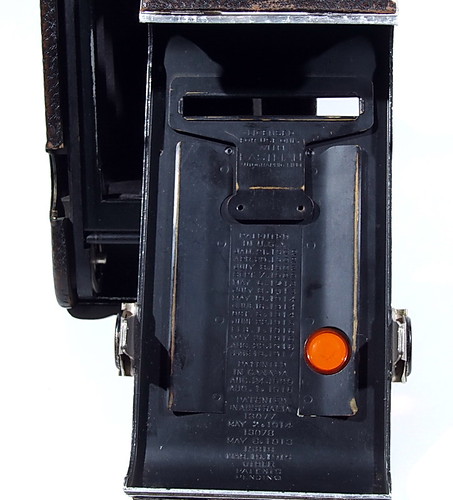
|
| Patents listed in the back of an Autographic Junior No. 1 image by Süleyman Demir (Image rights) |
- US Patent 1272415, Method of and apparatus for producing designations upon photographic material, filed 23 March 1911 (as application no. 616428: see the following two patents), and granted 16 July 1918 to H.J. Gaisman, as assignor to Eastman Kodak Corporation. The patent describes a method of leaving marks that will appear in the negative upon development, by writing on the film, which is beneath a lightproof but flexible cover, with a stylus. Gaisman specifically allows for two ways this might work: (i) by the transfer of powdered material (i.e. carbon, from a duplicating paper) to the film, under the stylus' pressure, and (ii) any direct effect of the pressure on the film itself: it is stated that writing on the film against a roughened or patterned support also produces lettering in the negative, but this is only one option. In the basic form of the camera described, the roll film passes across a narrow shelf, on which is mounted a strip of carbon paper (or a textured panel). Thus writing with the stylus transfers carbon to the emulsion side of the film, before exposure in the camera. The shelf, which is required to allow the stylus to apply suitable pressure, must then be moved out of the way before exposure. An alternative design is described, in which the writing panel is positioned at the top of the camera; the film is written on, then advanced, and only then exposed; this removes the need to move the supporting shelf each time.
- US Patent 1359245, Photographic apparatus, originally filed 23 March 1911 as part of no. 616428, but divided and re-filed separately 29 March 1912 and granted 16 November 1920 to Gaisman, again as assignor to Eastman Kodak. The patent describes a refinement of the basic autographic feature, in which a transparent tape passes across the front of the film in the exposing frame of the camera. This is held on feed and uptake rollers. Before passing into the film compartment, the tape passes across the back of the camera, where the user can write the desired inscription. The tape need not be advanced for every exposure; the same legend can be used for a series of pictures.
- US Patent 1359246, Apparatus for producing designations upon photographic material, again originally filed as part of no. 616428, but divided and re-filed separately 28 May 1917, and granted 16 November 1920 to Gaiman and Eastman Kodak. This patent describes another refinement of the feature, in which inscriptions are written on small strips of transparent material (it suggests celluloid or gelatin). The strip is mounted in a stiffening frame, and inserted into the camera through a slot.
- US Patent 1249612, Photographic apparatus, filed 29 March 1912 and granted 11 December 1917, again to Gaisman as assignor to Eastman Kodak. This patent describes an implementation of the idea above, in a folding roll-film camera. The holder carrying the inscription is placed in a tray on one side of the camera, the tray is closed to light, and the holder then swung into position.
- US Patent 1230399, Photographic apparatus, filed 29 March 1912 and granted 19 June 1917 to Gaisman and Eastman Kodak. This patent describes a camera a little more like those Eastman eventually sold. A panel in the camera back can be opened, allowing the user to write on a section of the film protected from exposure via the lens. Beneath the writing panel, the film is still protected by an opaque but flexible cover. Under this, the film passes across a supporting 'beam' made from glass, with a roughened upper surface. Under pressure from the stylus, the surface of this beam makes impressions in the emulsion which lessen its response when exposed to light. The light to expose the written panel enters via two tubes under the cover, one leading to each end of the glass beam. The light passes along the beam itself, so the film is exposed from the emulsion side, although the light enters from the cover in the back.
- US Patent 1238504, Method of and means for producing designations on photographically-sensitive elements, filed 14 April 1913 and granted 28 August 1917 to Gaisman as assignor to Eastman Kodak, describing several possible structures of an Autographic roll film, including that actually made.
- US Patent 1238505, Photographic apparatus, filed 6 May 1913 and granted 28 August 1917 to Gaisman as assignor to eastman Kodak, describing the Autographic camera substantially as it was made, with a single writing window in the back, aligned with one end of the film frame, which acts as the support for writing. The camera is to be used with roll film incorporating a carbon paper in the backing, one of the designs described in Patent 1238504.
- US Patent 1238506, Method and device for designating photographic exposures, filed 15 May 1913 and granted 28 August 1917 to Gaisman, as assignor to Eastman Kodak. This patent describes another camera, in which the film has an opaque leader paper, but is protected for most of its length by a translucent backing paper. The camera is equipped with a roll of carbon paper, not attached to the film spool; the desired inscription is written with the stylus on the carbon paper, and the writing is thus transferred to the translucent backing paper. The carbon paper is then lifted to expose the backing paper to light under the writing window.
- British Patent 9007 of 1914, Improvements in or relating to the production of designation marks on sensitized photographic elements and to apparatus therefor, filed 9 April 1914 and granted 29 October 1914 to Gaisman (with no mention of Eastman Kodak). The patent refers to its American equivalent, filed 15 May 1913, which is presumably no. 1238506, above, but is written somewhat differently. It describes a film protected by a backing paper with a carbon coating. The patent states that there may be a transparent later between this and the back of the film; the only purpose of this layer, if present, is to accept the transferred carbon, so that it is not left on the film. The cover of the writing window in the camera back is more complex than in other designs; it is a hinged cover, with a second hinged cover set in it. There is a flexible, opaque membrane under the cover. If the inner cover is opened, the membrane still protects the film. This is done to write with the stylus. The outer cover is then opened, and this lifts the membrane with it, to expose the backing paper. Writing an inscription reduces the opacity of the carbon paper, and enough light then passes through it to expose the film, leaving the impression of the text in the negative.
- British Patent 5043 of 1915, Improvements in or relating to photographic cameras, filed 1 April 1915 and granted 19 August 1915 to Gaisman (with no mention of Eastman Kodak). The patent refers to its American equivalent of 3 April 1914, not at Espacenet. This patent describes a different design again: in this camera, the film is protected from light by both a carbon-paper layer and a second backing paper. There is no lightproof membrane under the writing window. The two backing paper layers together are sufficient to protect the film from light, but as in the above design, writing an inscription reduces the opacity of the carbon-paper layer enough that the text is recorded by the film.
- US Patent 1256784, Marking photographic material, filed 22 July 1916 and granted 19 February 1918 to Gaisman, as assignor to Eastman Kodak. This patent describes possible versions of the Autographic film roll. One is shown in which there is a leader strip of normal opaque backing paper (there is a conventional paper leader at the end of the roll too); this stops where the film begins, and is replaced with a single-layer backing paper with carbon coating (not a two-layer backing as in the patent above). It is proposed that there may be a layer of lacquer applied over the carbon, so that, although the continuity of the carbon layer is disrupted by writing with the stylus, the carbon is not deposited on the film. A second arrangement is shown, in which the carbon layer is on the outside (away from the film), further to ensure that carbon does not become attached to the film.
- US Patent 1396035, Method of and apparatus for designating photographic exposures, filed 12 September 1921 and granted 8 November 1921 to Gaisman as assignor to Eastman Kodak. This patent describes yet another design which was not made, in which a translucent sheet (of glass or celluloid) bearing the hand-written inscription is held either in front of the roll film during exposure through the lens, or held behind it, to leave a shadow during exposure through a special window. The translucent sheet can be withdrawn sideways from the camera body, in a special bellows, with a light-proof flap which closes after it, so it can be taken out to write an inscription. The camera can be used without the autographic sheet.